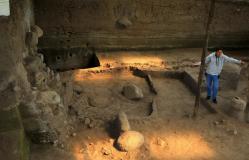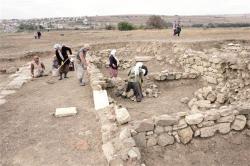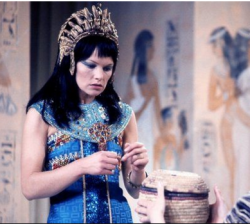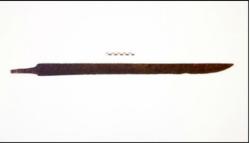INSTITUT SUPERIEUR D'ANTHROPOLOGIE
INSTITUTE OF ANTHROPOLOGY
ONLINE COURSES / COURS A DISTANCE
WINTER TERM : JANUARY 2016
REGISTER NOW
EQUATEUR –  Monta - Russian archeologists have discovered in Ecuador traces of an ancient culture dating back some 5,500 years, expedition head Alexander Popov said on Wednesday. The team of experts from Moscow, Novosibirsk in Siberia and Vladivostok in the Far East unearthed ceramics, tools, shells, bones and two burials sites near the city of Monta, located on the Pacific Coast, Popov said. "The artefacts will help analyze the origin of ceramics on the Pacific coast," he added. Russian archeologists have been involved in excavations in Ecuador for three years. Their purpose is to compare ancient cultures on different sides of the Pacific. "Research aims to establish connections between ways of mankind’s adaptation to a changing environment in different parts of the world," Popov said. "We see that people invented ceramics approximately in the same period of time." "Such comparative analysis has never been conducted, which makes our experiment unique," he said.
Monta - Russian archeologists have discovered in Ecuador traces of an ancient culture dating back some 5,500 years, expedition head Alexander Popov said on Wednesday. The team of experts from Moscow, Novosibirsk in Siberia and Vladivostok in the Far East unearthed ceramics, tools, shells, bones and two burials sites near the city of Monta, located on the Pacific Coast, Popov said. "The artefacts will help analyze the origin of ceramics on the Pacific coast," he added. Russian archeologists have been involved in excavations in Ecuador for three years. Their purpose is to compare ancient cultures on different sides of the Pacific. "Research aims to establish connections between ways of mankind’s adaptation to a changing environment in different parts of the world," Popov said. "We see that people invented ceramics approximately in the same period of time." "Such comparative analysis has never been conducted, which makes our experiment unique," he said.
http://tass.ru/en/society/830559?
TURQUIE –  Heraion Teikhos - Crucial findings in ancient Heraion-Teikhos in Turkey’s Thracian province of Tekirdağ, which illuminates the life of the ancient Thracian people, are being threatened by illegal treasure hunters, according to the head of the excavations in the field. Studies at Heraion-Teikhos have been continuing since 2000 and the site was a private plot until last year, which helped to protect the area, said Prof. Neşe Atik, the head of the archaeology department at Namık Kemal University. “This site became a target for illegal diggers immediately when it became public,” she told Anadolu Agency. During a one-month break in excavations for a geophysics study, illegal treasure hunters dug a one-and-a-half meter deep hole under a stone, she exemplified. Earlier this year, a 2000-year-old health center was discovered in the 5000-year-old city. There was an underground water system in the city which carried water to the health center and amphorae were used to distill the water, the excavation head said. “We had dig out a large amphora used for such a purpose which was totally empty, but they [treasure hunters] broke it into pieces,” she said. The treasure hunters are also pulling down the antique walls at the site in search for valuable materials, she said, complaining this was causing them lose energy and time, as the illegal attacks were leaving nothing to display.
Heraion Teikhos - Crucial findings in ancient Heraion-Teikhos in Turkey’s Thracian province of Tekirdağ, which illuminates the life of the ancient Thracian people, are being threatened by illegal treasure hunters, according to the head of the excavations in the field. Studies at Heraion-Teikhos have been continuing since 2000 and the site was a private plot until last year, which helped to protect the area, said Prof. Neşe Atik, the head of the archaeology department at Namık Kemal University. “This site became a target for illegal diggers immediately when it became public,” she told Anadolu Agency. During a one-month break in excavations for a geophysics study, illegal treasure hunters dug a one-and-a-half meter deep hole under a stone, she exemplified. Earlier this year, a 2000-year-old health center was discovered in the 5000-year-old city. There was an underground water system in the city which carried water to the health center and amphorae were used to distill the water, the excavation head said. “We had dig out a large amphora used for such a purpose which was totally empty, but they [treasure hunters] broke it into pieces,” she said. The treasure hunters are also pulling down the antique walls at the site in search for valuable materials, she said, complaining this was causing them lose energy and time, as the illegal attacks were leaving nothing to display.
http://www.hurriyetdailynews.com/treasure-hunters-destroying-precious-thracian-relics-in-turkey-.aspx?pageID=238&nid=90134
EGYPTE –  Dahshur - Entitled Scan Pyramids, an international project to uncover the secrets of the pyramids, is to be implemented at the end of October, Egypt's antiquities minister revealed to Ahram Online in an exclusive interview. Mamdouh Eldamaty said that the project aims to solve the enigma of the Old Kingdom pyramids at Dahshur and Giza and to provide a better understanding of their architecture and interior designs. The project, Eldamaty continued, will also provide 3D photos and a detailed study of pyramidal architecture in Egypt. "The survey will be implemented through invasive -- though non-destructive -- scanning techniques using cosmic rays in cooperation with scientists and experts from Japan, France and Canada," Eldamaty said. "King Senefru's Bent Pyramid in Dahshur was selected to be the first pyramid that will be subjected to such a survey due to its distinguished and unique architectural design and because it is the first attempt at pyramid construction that has not been carefully studied," Eldamaty told Ahram Online.
Dahshur - Entitled Scan Pyramids, an international project to uncover the secrets of the pyramids, is to be implemented at the end of October, Egypt's antiquities minister revealed to Ahram Online in an exclusive interview. Mamdouh Eldamaty said that the project aims to solve the enigma of the Old Kingdom pyramids at Dahshur and Giza and to provide a better understanding of their architecture and interior designs. The project, Eldamaty continued, will also provide 3D photos and a detailed study of pyramidal architecture in Egypt. "The survey will be implemented through invasive -- though non-destructive -- scanning techniques using cosmic rays in cooperation with scientists and experts from Japan, France and Canada," Eldamaty said. "King Senefru's Bent Pyramid in Dahshur was selected to be the first pyramid that will be subjected to such a survey due to its distinguished and unique architectural design and because it is the first attempt at pyramid construction that has not been carefully studied," Eldamaty told Ahram Online.
http://english.ahram.org.eg/NewsContent/9/40/161327/Heritage/Ancient-Egypt/Egypts-Minister-of-Antiquities-reveals-to-Ahram-On.aspx
EGYPTE –  The story that Cleopatra, ancient queen of Egypt, was killed by a snake bite has been rejected as "impossible" by University of Manchester academics. Egyptologists and snake experts have combined to examine the plausibility of the tale of the queen being killed by a cobra hidden in a basket of figs. They believe a snake big enough to kill the queen and two maids would not have been small enough to be concealed. They also challenge the credibility of three consecutive fatal bites. Cleopatra, who died at the age of 39 in 30BC, was a ruler of Egypt who became embroiled in power struggles within the Roman empire. From Roman sources onwards, her death has often been attributed to a poisonous snake or "asp", with the queen using the fatal bite as a way of ending her own life. But Egyptologist Joyce Tyldesley and Andrew Gray, curator of herpetology at Manchester Museum, say the supposed culprit - a cobra - would have been too physically big to be concealed in the way that has been portrayed.They are typically 5-6ft long and can grow to 8ft (2.5m), and the Manchester experts reject the idea such a snake could be hidden in the way suggested. Even if such a snake had been smuggled in to Cleopatra, they say it would have been very unlikely that it could have killed Cleopatra and two of her servants in quick succession. "Not only are cobras too big, but there's just a 10% chance you would die from a snake bite: most bites are dry bites that don't inject venom," said Mr Gray. "That's not to say they aren't dangerous: the venom causes necrosis and will certainly kill you, but quite slowly."So it would be impossible to use a snake to kill two or three people one after the other. "Snakes use venom to protect themselves and for hunting - so they conserve their venom and use it in times of need."
The story that Cleopatra, ancient queen of Egypt, was killed by a snake bite has been rejected as "impossible" by University of Manchester academics. Egyptologists and snake experts have combined to examine the plausibility of the tale of the queen being killed by a cobra hidden in a basket of figs. They believe a snake big enough to kill the queen and two maids would not have been small enough to be concealed. They also challenge the credibility of three consecutive fatal bites. Cleopatra, who died at the age of 39 in 30BC, was a ruler of Egypt who became embroiled in power struggles within the Roman empire. From Roman sources onwards, her death has often been attributed to a poisonous snake or "asp", with the queen using the fatal bite as a way of ending her own life. But Egyptologist Joyce Tyldesley and Andrew Gray, curator of herpetology at Manchester Museum, say the supposed culprit - a cobra - would have been too physically big to be concealed in the way that has been portrayed.They are typically 5-6ft long and can grow to 8ft (2.5m), and the Manchester experts reject the idea such a snake could be hidden in the way suggested. Even if such a snake had been smuggled in to Cleopatra, they say it would have been very unlikely that it could have killed Cleopatra and two of her servants in quick succession. "Not only are cobras too big, but there's just a 10% chance you would die from a snake bite: most bites are dry bites that don't inject venom," said Mr Gray. "That's not to say they aren't dangerous: the venom causes necrosis and will certainly kill you, but quite slowly."So it would be impossible to use a snake to kill two or three people one after the other. "Snakes use venom to protect themselves and for hunting - so they conserve their venom and use it in times of need."
http://www.bbc.com/news/education-34594812
NORVEGE –  Haukeli - A hiker travelling the ancient route between western and eastern Norway found a 1,200-year-old Viking sword after sitting down to rest after a short fishing trip. The sword, found at Haukeli in central southern Norway will be sent for conservation at the The University Museum of Bergen.nJostein Aksdal, an archeologist with Hordaland County said that the sword was in such good condition that if it was given a new grip and a polish, it could be used today.“When the snow has gone in spring, we will check the place where the sword was found. If we find several objects, or a tomb, perhaps we can find the story behind the sword,” he said. He said that judging by the sword’s 77cm length, it appeared to come from 750-800AD. “This was a common sword in Western Norway. But it was a costly weapon, and the owner must have used it to show power,” he said.
Haukeli - A hiker travelling the ancient route between western and eastern Norway found a 1,200-year-old Viking sword after sitting down to rest after a short fishing trip. The sword, found at Haukeli in central southern Norway will be sent for conservation at the The University Museum of Bergen.nJostein Aksdal, an archeologist with Hordaland County said that the sword was in such good condition that if it was given a new grip and a polish, it could be used today.“When the snow has gone in spring, we will check the place where the sword was found. If we find several objects, or a tomb, perhaps we can find the story behind the sword,” he said. He said that judging by the sword’s 77cm length, it appeared to come from 750-800AD. “This was a common sword in Western Norway. But it was a costly weapon, and the owner must have used it to show power,” he said.
http://www.thelocal.no/20151021/hiker-finds-1300-yr-old-viking-sword?